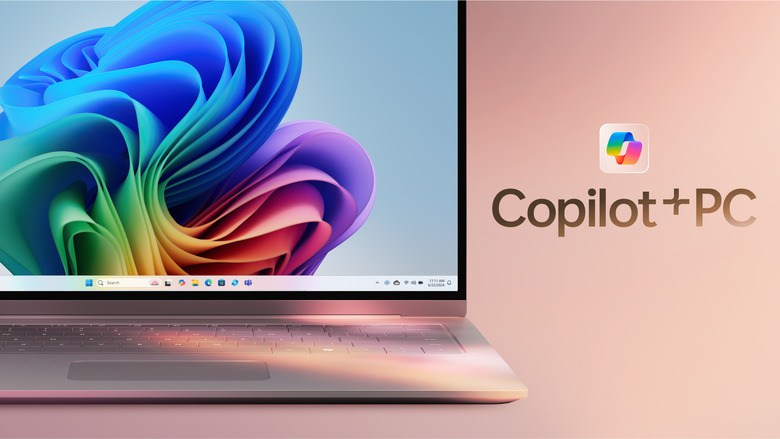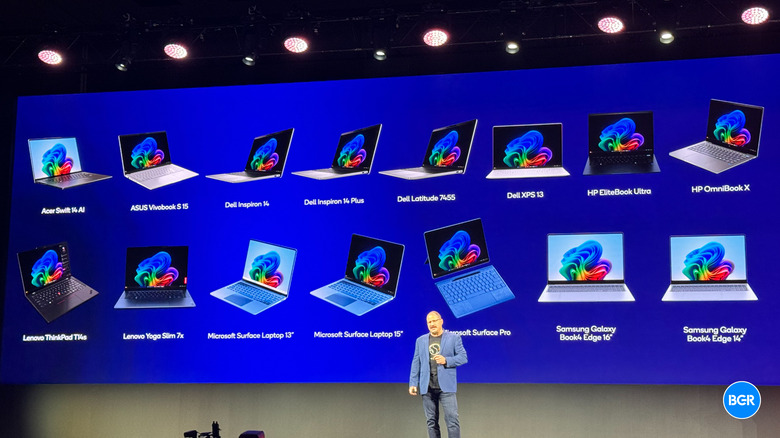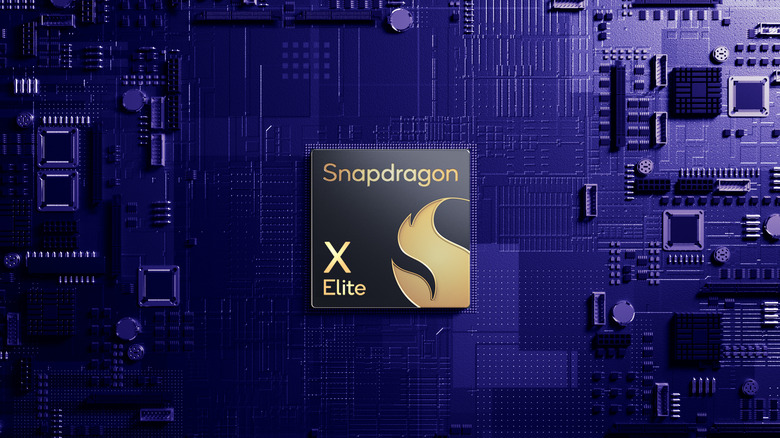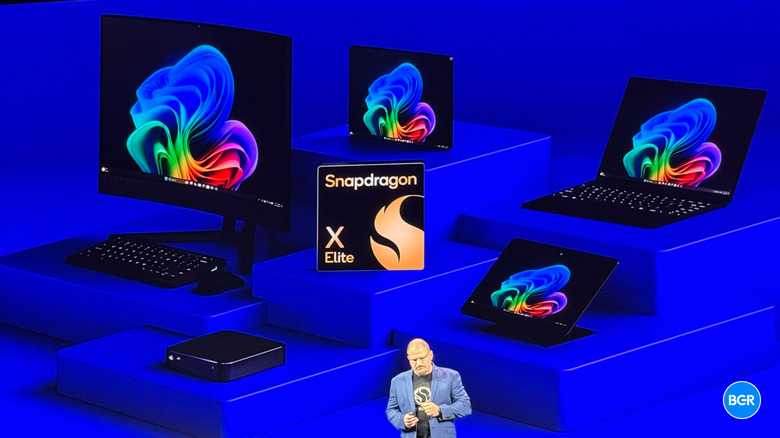The Windows On Arm Revolution Might Finally Be Here
Windows on Arm has had a long road. Microsoft's PC platform has actually been available on Arm-based computers for a long time now — but to date, getting a Windows on Arm PC has meant sluggish performance and poor app support, just for better battery life. Now, that could be finally changing — thanks to the launch of Qualcomm's new Snapdragon X Elite.
The Qualcomm Snapdragon X Elite is being heralded as the Windows ecosystem's answer to the Apple M series — an answer that is long-awaited, and much-needed in a market dominated by the likes of Intel and AMD. Apple, however, has a four-year lead in developing high-performance computing chips that deliver on the promise of class-leading performance in a hyper-efficient chip.
This particular moment represents a massive shift for the PC industry in general. As mentioned, the Windows world has long been dominated by the likes of Intel and AMD — and while Qualcomm has made PC plays in the past, they've been to little fanfare and with few available devices.
This time around, things seem a little different. At launch, there will be over 20 Snapdragon X Elite SKUs, though how Qualcomm counts those models does inflate the number a little (multiple sizes of the same laptop count as two). Companies from Dell, to Lenovo, to Microsoft itself is launching with thin-and-light Copilot+ Snapdragon X Elite models — a show of force that I can't recall seeing at any time in the PC space in the past.
Qualcomm flew me out to Computex in Taipei to check out Snapdragon X Elite chips in person, and I have to say, I'm hesitantly excited about what's to come.
AI everywhere
The Windows on Arm moment also happens to coincide with the AI moment, which is more or less perfect for Qualcomm. Why? Qualcomm is good at AI — it has been building AI-specific chips, called Neural Processing Units or NPUs, into Snapdragon-powered phones for some time now.
The results of building NPUs into Windows laptops will be easy to see at launch. Copilot+ PCs, which at launch will only be powered by Snapdragon X Elite chips, offer more AI features than Windows computers in the past — and many of those features are processed locally by the Snapdragon X Elite's NPU.
Features like Recall and Cocreate, for example, are largely enabled by the kind of AI processing power on offer by the Snapdragon X Elite — and that will surely come to other ARM chips for the PC in the future. The likes of Intel and AMD are touting their ability to process AI tasks, and Nvidia is set to join the industry in the near future, too.
Back to the basics
But AI isn't everything — and frankly, while there's a ton of hype around AI, it's not the main use case for laptops just yet. That's where simple, basic performance comes into play. It's far more important than AI performance right now, and will have a massive, direct impact on day-to-day use.
So, how will Snapdragon X Elite laptops perform? Well, we don't really know just yet, as we haven't yet been able to actually use one. Qualcomm has shown off plenty of graphs and metrics that seemingly paint its laptops in a pretty positive light — and to be fair, it's doubtful all of the laptop-makers that have jumped on board would jump on board if they were skeptical about how Qualcomm's chips would perform.
But there is still some reason to pause. Qualcomm has touted the Snapdragon X Elite's performance-per-watt prowess, noting that the chip is 2.6x faster than the M3 in performance per watt. But it has remained a little quiet about single-core performance compared to the M3. Instead, the company showed off graphs comparing the Snapdragon X Elite with power-hungry x86 chips like the AMD Ryzen 9 7940HS and the Intel Core i9 185H, noting that the Snapdragon X Elite will offer 51% faster CPU performance at the same power. That's not surprising at all, and in fact, it should be much faster than those chips. However, Apple also offers around 50% better single-core performance than those chips.
Now, none of this is to say that the Snapdragon X Elite won't offer great single-core performance. If the M3 is faster than the Snapdragon X Elite at all, it would make sense for Qualcomm not to compare the two — however even if the Snapdragon X Elite gets close, it'll be a huge win for Qualcomm. That, of course, doesn't take into account the performance of the new M4 — but again, if Qualcomm can get in the same ballpark, the Snapdragon X Elite will make for a great laptop.
Not for everyone (yet)
There are use cases where the Snapdragon X Elite probably won't work for you. Perhaps the primary use case is in gaming. The Snapdragon X Elite won't be a gaming slouch — and in fact, will hopefully beat out the integrated graphics performance on offer by the likes of Intel. But that still won't necessarily be enough for demanding gamers.
It's entirely possible that the Snapdragon X Elite will one day support either discrete graphics cards or eGPUs, and Qualcomm pointed out in a Q&A at Computex that there were no "technical limitations" around using the Snapdragon X Elite with non-Qualcomm graphics cards. Qualcomm has also said in the past that it will be up to OEMs to decide if they want to use discrete graphics alongside the Snapdragon X Elite. For now, Snapdragon-powered PCs probably won't be right for gamers, though.
Of course, Qualcomm has to start somewhere, and to be fair, so far we've only seen thin laptops with the chip get announced. Long-term, it's very likely we'll see Qualcomm build more graphics-focused PC chips.
Battle it out
Qualcomm has the advantage of being first to market when it comes to high-performance Arm chips, but unlike the Mac space, in the Windows space chip-makers have to compete — a lot. It's actually pretty huge that Qualcomm has been able to get to this point, considering the long-term dominance of Intel, and to a lesser extent, AMD. But, Qualcomm won't be alone.
For starters, Intel won't be taking this on the chin. Intel recently unveiled its latest-gen "Lunar Lake" chips, which is says will prove that Arm isn't more efficient than x86 after all. Lunar Lake chips also happen to have much larger AI accelerators built onto them, and it's very likely we'll see Intel-based Copilot+ PCs at some point in the near future.
Nvidia could be a major competitor in the near future too. Reports have surfaced that the company is working on its own Arm-based chips to compete with the likes of Intel, AMD, and Qualcomm. However, we have yet to see these new chips in person, and have no idea how they'll eventually perform in the real world.
An exciting future
It feels like Arm on Windows is the clear future. Arm-based chips are much more power-efficient, and if done right, will make for a much better laptop experience on Windows computers, like they did on the Mac. And, if Snapdragon X Elite does indeed kick of this shift in the way that it seemingly will, Arm has an exciting future in the PC space.
Qualcomm teased some of this future, too. At its keynote at Computex 2024, the company showed off a slide that puts the Snapdragon X Elite in tablets, all-in-ones, and even Mini-PCs. Notably absent from that slide is a tower PC — but as it expands the Snapdragon X lineup, there's no reason we won't see Arm-based chips built for high-performance video editing and gaming.
It's important not to get ahead of ourselves, though. We're hoping to review some of the new Snapdragon X Elite laptops in the very near future. It's impossible to tell the future, but if Qualcomm can reinvent the Windows processor, it could end up having a bigger impact on the PC than the M1 had on the Mac — especially given how Windows device manufacturers like to experiment.




